While reading about Edgar Allan Poe’s “The Island of the Fay” (for yesterday’s post), I wondered about the source for the story’s setting. According to a Wikipedia article, another Poe story (“A Tale of the Ragged Mountains”) is “the only one of Poe’s stories to take place in Virginia.” I doubt very much that this is true.
“A Tale of the Ragged Mountains” might be the only Poe story set explicitly in Virginia, but considering Poe’s biography and where he lived at different times in his rather brief life (only 40 years), these low but rugged mountains emerge as a compelling candidate for the wild landscape that may have influenced several of his writings.
A well-researched article on Poe’s one year at the University of Virginia in Charlottesville reports that “in the afternoons, Poe was reputed to take long solitary walks through the nearby hills ...” In “A Tale of the Ragged Mountains”, Poe gives this habit to his main character. He would
set forth alone, or attended only by a dog, upon a long ramble among the chain of wild and dreary hills that lie westward and southward of Charlottesville, and are there dignified by the title of the Ragged Mountains.
Poe later has his character say that “when I left Charlottesville ... I bent my steps immediately to the mountains” – this is probably what Poe himself was once in the habit of doing.
In “The Island of the Fay,” the place where the narrator walks is described in a manner very reminiscent of his account of the Ragged Mountains.
It was during one of my lonely journeyings, amid a far distant region of mountain locked within mountain, and sad rivers and melancholy tarn writhing or sleeping within all – that I chanced upon a certain rivulet and island.
Poe’s ‘fancy’ could take something very small and seemingly insignificant – like a piece of sycamore bark floating by – and blow it up into something central to a story. There is every possibility that the ‘river’ where “Fay” is based indeed was nothing more than a ‘rivulet’, and the island perhaps not much more than a typical small feature of a Virginia creek, no more than a few meters from end to end. Setting off from the university “southward and westward” as he says, and following the Ragged Mountains, Poe would encounter the main branch of Moore’s Creek, which today feeds a reservoir near the university. Traveling further south, he’d reach the Hardware River; either stream would have been quite suitable as the basis for “The Island of the Fay.”
Based on the other places where Poe spent his adult life – Philadelphia, New York and Baltimore, with a military assignment to Charleston, South Carolina – it seems likely he would have become familiar with territory like that in “The Island of the Fay” (and perhaps even the setting of “The Fall of the House of Usher”) in the Ragged Mountains. Another possibility might be the area near West Point, where he spent about eight months trying mightily, and finally succeeding, to get himself kicked out of the U.S. Military Academy. And of course there’s the fact that he was brought up during part of his childhood in Scotland and England, and was always perfectly capable of simply making up his own worlds. But I suspect the Ragged Mountains provided a reserve of impressions that he drew upon for ‘wild’ scenery.
An aside: Having just recently written about the possible meaning of ‘Indian Summer’ and also the prevalence during that time of a combination of “sun, dust, smoke and shadow – a medium that contains and conducts autumn” – I enjoyed encountering Poe’s reference, in “A Tale of the Ragged Mountains,” to
a dim, warm, misty day, toward the close of November ... during the strange interregnum of the seasons which in America is termed the Indian Summer
and his description of
the thick and peculiar mist, or smoke, which distinguishes the Indian Summer ... this pleasant fog
Of course, some people, influenced by malicious, largely untrue tales disseminated about Poe during his lifetime, may think I’m seeking corroboration from an addicted madman. Well, Happy Halloween to them.
Finally, even further aside. I’ve written quite a bit (here, here, here and here) about my uncle, the late photographer and commercial filmmaker Del Ankers. Getting a gift for my uncle Del was the closest thing we knew to trying to find something for the fabled ‘man who has everything’. The D.C. studio/home of Del and my aunt Elizabeth was a marvel to my siblings and me, filled with exotic things like glass-topped tables, curved, leather-covered sofas, fresh fruit set out in bowls (and you were actually encouraged to eat it), sumptuous atlases and coffee table books on the aforementioned tables, not to mention all the photo stuff in the studios. The best things were the crazy toys on Del’s desk – not toys for us, souvenirs and amusements for him.
I only ever managed to find two or three things worth giving Del for his collection. One of them dates from just a few years ago, a toothpick dispenser I also just had to get for myself. Works great. And it can close our chapter on Edgar Allan Poe.
 Quoth the Raven, “Need one more?”
Quoth the Raven, “Need one more?”
 William Theodore Van Doren. Stony Point, Albemarle County, Va. Oil on paper, 16 x 20.
William Theodore Van Doren. Stony Point, Albemarle County, Va. Oil on paper, 16 x 20. Sunday, November 8, 2009 at 06:16PM | by
Sunday, November 8, 2009 at 06:16PM | by  BVD | in
BVD | in  Sunset Paintings,
Sunset Paintings,  Sunsetology | tagged
Sunsetology | tagged  Blue Ridge,
Blue Ridge,  Charlottesville Virginia,
Charlottesville Virginia,  indian summer,
indian summer,  painting process | | Comments Off
painting process | | Comments Off 
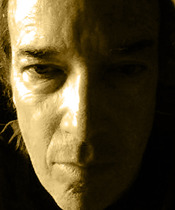
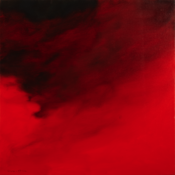
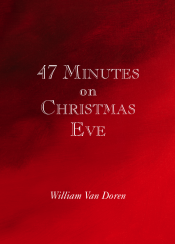
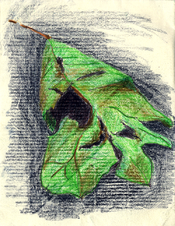


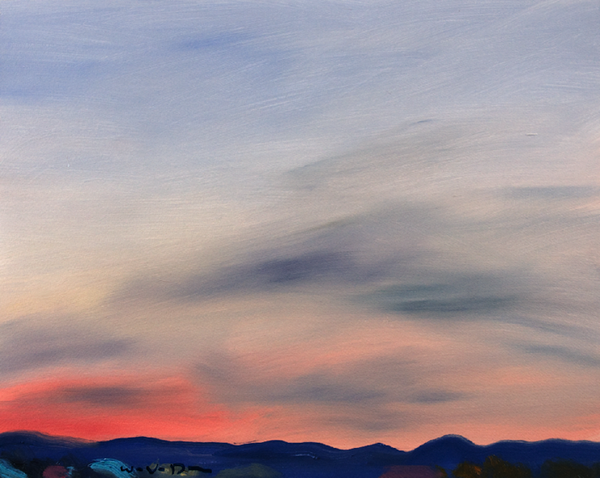
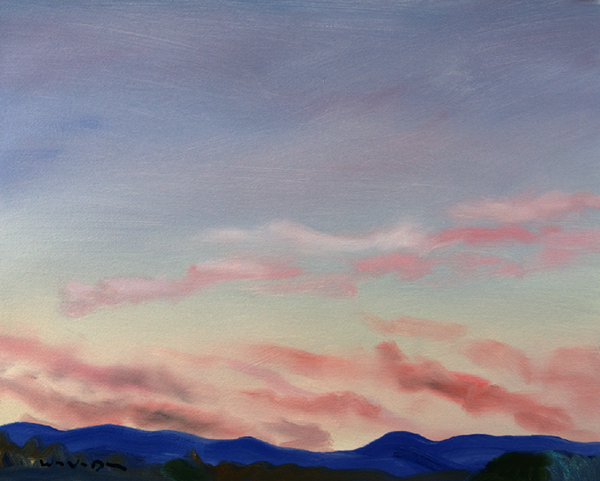
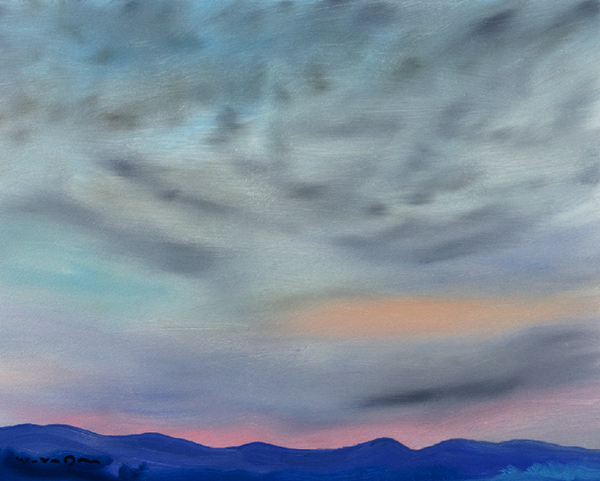
On the Origins of ‘Indian Summer’
Now we have Indian Summer, for maybe three days, starting yesterday. The closest thing to an official definition of this unofficial, undefined phenomenon is any autumn day over 70°F after the first frost. Sometimes this is supposed to mean the first killing frost, but lately I’ve been cheating and just any widespread frost will do.
You can read a lot of very interesting stuff about Indian Summer, presented in painfully uninteresting fashion, on the globalinterspiderweb, for example in the Wikipedia entry and in a USA Today piece borrowed, it seems, from a regional office of the U.S. Weather Service. The article by the Weather Service historian is particularly nice in its descriptions of Indian Summer.
It’s in trying to account for the term’s origins that these sources and others get a little strange. I can’t say that the sources are wrong, only that there’s a highly suspicious disconnect between the supposed etymology and the way the term is used – its sensual, emotional, even poetic connotations. I realize that such disconnects are common in etymology – a term often ends up meaning something completely divorced from its original context. But this is a case where other, better explanations are sitting right there at hand.
Maybe somehow, at some point, ‘Indian Summer’ really did have something to do with a period of the year when Indians were more likely to attack colonists, or colonists were likely to attack Indians (two of the leading theories). Maybe it really even derived from the ‘I.S.’ line marked on the outside of sailing ships – denoting the safe level to which one could load cargo for the Indian Ocean in the summer, i.e., Indian [Ocean] Summer [Level]. But somehow such explanations strike me as a triumph of mechanistic ‘history detective’ logic over common sense.
My theory, which isn’t all that theoretical, takes into account that, among the many terms for similar autumnal warm spells in other cultures, there’s also a ‘Gypsy Summer’, in southeastern Europe. I think the name must somehow be related to the mellow perfection of the weather and the sense of ease and well-being it tends to produce. At times like these, even you or I might be capable of living simply and directly, outdoors, like a native American or one of the Romani people. Not that I believe this exact thought is the source of the term, but it’s easy to associate such beneficent conditions with the people who live in the woods and fields. On an Indian Summer day, there’s no need for shelter from the rain, summer insects have been nipped by the frost, there’s neither the broiling heat of August nor the cold wet snow of February – it’s the kind of day when civilized or technological intervention is least needed and in fact only gets in the way.
Or I would put it like this: On a mild day in late October or early November, sit and face the sun, down out of the wind, in the tall dry grasses, your back against a line of trees. The sun turns you into a checkerboard of alternating squares of light and self. After a while you don’t know where you end and the sun begins. That’s because there is no such place. At that moment, any one of us is a true aboriginal of this splendid world.